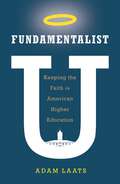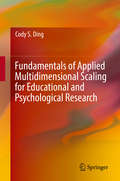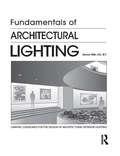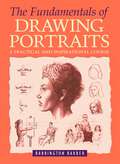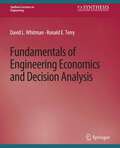- Table View
- List View
Fundamental Neuroscience for Basic and Clinical Applications E-Book: With Student Consult Online Access
by Duane E. Haines Gregory A. MihailoffUsing a rigorous yet clinically-focused approach, Fundamental Neuroscience for Basic and Clinical Applications, 5th Edition, covers the fundamental neuroscience information needed for coursework, exams, and beyond. It integrates neuroanatomy, pharmacology, and physiology, and offers a full section devoted to systems neurobiology, helping you comprehend and retain the complex material you need to know. Highlights clinical content in blue throughout the text, helping you focus on what you need to know in the clinical environment.Presents thoroughly updated information in every chapter, with an emphasis on new clinical thinking as related to the brain and systems neurobiology. Features hundreds of correlated state-of-the-art imaging examples, anatomical diagrams, and histology photos – nearly half are new or improved for this edition. Pays special attention to the correct use of clinical and anatomical terminology, and provides new clinical text and clinical-anatomical correlations.
Fundamental Physics and Physics Education Research (Springer Proceedings In Physics Ser. #145)
by Burra G. Sidharth Jesús Carnicer Murillo Marisa Michelini Carmen PereaThis book highlights selected contributions presented at the 15th annual international symposium Frontiers of Fundamental Physics (FFP15), with the aim of informing readers about the most important recent advances in fundamental physics and physics education research. The FFP series offers a platform for physicists from around the world to present their latest theories and findings. The latest symposium was held in Orihuela, Spain and covered diverse fields of research, including gravitation, astronomy and astrophysics, physics of complex systems, high-energy physics, and mathematical physics. Considerable attention was also paid to physics education research, teacher education in physics, and the popularization of physics. In a knowledge-based society, research into fundamental physics plays a vital role in both the advancement of human knowledge and the development of new technologies. Presenting valuable new peer-reviewed contributions submitted from 15 countries, this book will appeal to a broad audience of scholars and researchers.
Fundamentale Ideen der Informatik im Mathematikunterricht: Grundsätzliche Überlegungen und Beispiele für die Primarstufe
by Petra KnössFundamentalist U: Keeping the Faith in American Higher Education
by Adam LaatsColleges, universities, and seminaries do more than just transfer knowledge to students. They sell themselves as "experiences" that transform young people in unique ways. The conservative evangelical Protestant network of higher education has been no different. In the twentieth century, when higher education sometimes seemed to focus on sports, science, and social excess, conservative evangelical schools offered a compelling alternative. On their campuses, evangelicals debated what it meant to be a creationist, a Christian, a proper American, all within the bounds of Biblical revelation. Instead of encouraging greater personal freedom and deeper pluralist values, conservative evangelical schools thrived by imposing stricter rules on their students and faculty. In Fundamentalist U, Adam Laats shows that these colleges have always been more than just schools; they have been vital intellectual citadels in America's culture wars. These unique institutions have defined what it has meant to be an evangelical and have reshaped the landscape of American higher education. Students at these schools have been expected to learn what it means to be an educated evangelical in a secularizing society. This book asks new questions about that formative process. How have conservative evangelicals hoped to use higher education to instill a uniquely evangelical identity? How has this identity supported the continuing influence of a dissenting body of knowledge? In what ways has it been tied to cultural notions of proper race relations and proper relations between the sexes? And perhaps most important, how have students responded to schools' attempts to cultivate these vital notions about their selves? In order to understand either American higher education or American evangelicalism, we need to appreciate the role of this influential network of dissenting institutions. Only by making sense of these schools can we make sense of America's continuing culture wars.
Fundamentalist U: Keeping the Faith in American Higher Education
by Adam LaatsColleges, universities, and seminaries do more than just transfer knowledge to students. They sell themselves as "experiences" that transform young people in unique ways. The conservative evangelical Protestant network of higher education has been no different. In the twentieth century, when higher education sometimes seemed to focus on sports, science, and social excess, conservative evangelical schools offered a compelling alternative. On their campuses, evangelicals debated what it meant to be a creationist, a Christian, a proper American, all within the bounds of Biblical revelation. Instead of encouraging greater personal freedom and deeper pluralist values, conservative evangelical schools thrived by imposing stricter rules on their students and faculty. In Fundamentalist U, Adam Laats shows that these colleges have always been more than just schools; they have been vital intellectual citadels in America's culture wars. These unique institutions have defined what it has meant to be an evangelical and have reshaped the landscape of American higher education. Students at these schools have been expected to learn what it means to be an educated evangelical in a secularizing society. This book asks new questions about that formative process. How have conservative evangelicals hoped to use higher education to instill a uniquely evangelical identity? How has this identity supported the continuing influence of a dissenting body of knowledge? In what ways has it been tied to cultural notions of proper race relations and proper relations between the sexes? And perhaps most important, how have students responded to schools' attempts to cultivate these vital notions about their selves? In order to understand either American higher education or American evangelicalism, we need to appreciate the role of this influential network of dissenting institutions. Only by making sense of these schools can we make sense of America's continuing culture wars.
Fundamentals of Applied Multidimensional Scaling for Educational and Psychological Research
by Cody S. DingThis book explores the fundamentals of multidimensional scaling (MDS) and how this analytic method can be used in applied setting for educational and psychological research. The book tries to make MDS more accessible to a wider audience in terms of the language and examples that are more relevant to educational and psychological research and less technical so that the readers are not overwhelmed by equations. The goal is for readers to learn the methods described in this book and immediately start using MDS via available software programs. The book also examines new applications that have previously not been discussed in MDS literature. It should be an ideal book for graduate students and researchers to better understand MDS. Fundamentals of Applied Multidimensional Scaling for Educational and Psychological Research is divided into three parts. Part I covers the basic and fundamental features of MDS models pertaining to applied research applications. Chapters in this section cover the essential features of data that are typically associated with MDS analysis such as preference ration or binary choice data, and also looking at metric and non-metric MDS models to build a foundation for later discussion and applications in later chapters. Part II examines specific MDS models and its applications for education and psychology. This includes spatial analysis methods that can be used in MDS to test clustering effect of items and individual differences MDS model (INDSCAL). Finally, Part III focuses on new applications of MDS analysis in these research fields. These new applications consist of profile analysis, longitudinal analysis, mean-level change, and pattern change. The book concludes with a historical review of MDS development as an analytical method and a look to future directions.
Fundamentals of Architectural Lighting
by Samuel MillsThe theme of this book is that light is an inseparable part of architectural design, and is intended to provide students of architecture and interior design with a graphic guideline to the fundamental role lighting plays in this process. While simple light sources may be enough to satisfy practical needs, the design process must expand beyond basic illumination. The challenge for architects and designers is the creation of luminous environments offering visual interest and a sense of well-being, while also meeting basic seeing needs. Technological advances provide opportunities for the lighting designer's creative introduction of light, and the visual and psychological perceptions of the illuminated architectural environment. Fundamentals of Architectural Lighting offers a complete comprehensive guide to the basics of lighting design, equipping students and practitioners with the tools and ideas they need to master a variety of lighting techniques. The book is extensively illustrated with over 250 illustrations to demonstrate basic principles and procedures. It is an excellent resource for anyone interested in the fundamentals of integrated lighting for architectural interior spaces.
Fundamentals of Architectural Lighting
by Samuel MillsThe theme of this book is that light is an inseparable part of architectural design, and is intended to provide students of architecture and interior design with a graphic guideline to the fundamental role lighting plays in this process. While simple light sources may be enough to satisfy practical needs, the design process must expand beyond basic illumination. The challenge for architects and designers is the creation of luminous environments offering visual interest and a sense of well-being, while also meeting basic seeing needs. Technological advances provide opportunities for the lighting designer's creative introduction of light, and the visual and psychological perceptions of the illuminated architectural environment. Fundamentals of Architectural Lighting offers a complete comprehensive guide to the basics of lighting design, equipping students and practitioners with the tools and ideas they need to master a variety of lighting techniques. The book is extensively illustrated with over 250 illustrations to demonstrate basic principles and procedures. It is an excellent resource for anyone interested in the fundamentals of integrated lighting for architectural interior spaces.
Fundamentals of Clinical Practice: A Textbook On The Patient, Doctor, And Society
by Mark B. Mengel M.D., M.P.H. Warren L. Holleman Scott A. FieldsFundamentals of Clinical Practice, Second Edition presents medical students with a comprehensive guide to the social ramifications of a physician's work, and more experienced practitioners with the tools to augment their own patient-centered techniques.
Fundamentals of Curriculum: Passion and Professionalism
by Decker F. WalkerGraduate students and teachers of introductory graduate courses in curriculum have many textbooks to choose from. What is special about Fundamentals of Curriculum: Passion and Professionalism, Second Edition? Content and approach: Clear, focused, and tightly structured, this text provides essential information and resources education professionals need to effectively deal with the urgent and important curriculum problems they face in schools today. Part I ("Perspectives") looks at curriculum from five fundamental perspectives: curriculum work, traditions of curriculum practice, curriculum theories, curriculum reforms, and curriculum studies. Part II ("Practice") applies these perspectives to important curriculum challenges that arise when people try to improve curriculums in schools and classrooms. Chapter features: Each chapter opens with a thought-provoking quotation and a set of guiding questions, and ends with "Questions and Projects" and "Further Studies" essays that recommend readings, Web resources, and other ways to study more about the topic. Distinctive qualities: Comprehensive. Readers are acquainted with the major schools of thought, value systems, lines of activity, and forms of inquiry in the field. Rigorous. The most rigorous research and scholarship on curriculum questions is cited and described; research and scholarship are used to ground discussions of curriculum questions; readers are introduced to the considerations involved in doing rigorous studies of curriculum questions. Practical. First, the focus is on curriculum practice. Theory, research, and other important facets of curriculum studies are presented as vitally important to practice, but the primary subject is what teachers and others do that students experience. Second, the text is practical in a more philosophical sense, taking the fundamental questions of curriculum studies to be practical questions and the primary task of curriculum inquiry to be informing decisions about what to do. Professional. Curriculum matters are approached professionally both in the sense that the text is designed to prepare readers for professional roles doing curriculum work, and also in the moral and ethical sense that attention is paid throughout the book to the responsibility of curriculum professionals in the public schools to serve the public interest. New in the Second Edition: The essential message and basic structure of the first edition is preserved, but the text has been significantly reworked to be: *leaner and simpler--the number of chapters is reduced from 13 to nine and the number of pages reduced almost as much; *more tightly focused on the ideas, arguments, and examples that are essential learning for anyone entering the study of curriculum--chapters less central to the primary concerns of curriculum professionals and scholars have been cut; *throughly updated and strengthened as an introduction to research and scholarship in curriculum studies--many new excellent studies have been integrated, and examples, references, and recommended readings included; and *more direct--the practical, professional message that is the book's main message is more clearly articulated.
Fundamentals of Curriculum: Passion and Professionalism
by Decker F. WalkerGraduate students and teachers of introductory graduate courses in curriculum have many textbooks to choose from. What is special about Fundamentals of Curriculum: Passion and Professionalism, Second Edition? Content and approach: Clear, focused, and tightly structured, this text provides essential information and resources education professionals need to effectively deal with the urgent and important curriculum problems they face in schools today. Part I ("Perspectives") looks at curriculum from five fundamental perspectives: curriculum work, traditions of curriculum practice, curriculum theories, curriculum reforms, and curriculum studies. Part II ("Practice") applies these perspectives to important curriculum challenges that arise when people try to improve curriculums in schools and classrooms. Chapter features: Each chapter opens with a thought-provoking quotation and a set of guiding questions, and ends with "Questions and Projects" and "Further Studies" essays that recommend readings, Web resources, and other ways to study more about the topic. Distinctive qualities: Comprehensive. Readers are acquainted with the major schools of thought, value systems, lines of activity, and forms of inquiry in the field. Rigorous. The most rigorous research and scholarship on curriculum questions is cited and described; research and scholarship are used to ground discussions of curriculum questions; readers are introduced to the considerations involved in doing rigorous studies of curriculum questions. Practical. First, the focus is on curriculum practice. Theory, research, and other important facets of curriculum studies are presented as vitally important to practice, but the primary subject is what teachers and others do that students experience. Second, the text is practical in a more philosophical sense, taking the fundamental questions of curriculum studies to be practical questions and the primary task of curriculum inquiry to be informing decisions about what to do. Professional. Curriculum matters are approached professionally both in the sense that the text is designed to prepare readers for professional roles doing curriculum work, and also in the moral and ethical sense that attention is paid throughout the book to the responsibility of curriculum professionals in the public schools to serve the public interest. New in the Second Edition: The essential message and basic structure of the first edition is preserved, but the text has been significantly reworked to be: *leaner and simpler--the number of chapters is reduced from 13 to nine and the number of pages reduced almost as much; *more tightly focused on the ideas, arguments, and examples that are essential learning for anyone entering the study of curriculum--chapters less central to the primary concerns of curriculum professionals and scholars have been cut; *throughly updated and strengthened as an introduction to research and scholarship in curriculum studies--many new excellent studies have been integrated, and examples, references, and recommended readings included; and *more direct--the practical, professional message that is the book's main message is more clearly articulated.
The Fundamentals of Drawing: A Complete Professional Course for Artists
by Barrington BarberThis internationally bestselling guide covers essential drawing techniques, written by expert practical art author Barrington Barber.The Fundamentals of Drawing is a practical and comprehensive drawing course from beginner to advanced levels. Opportunities for practice and improvement are offered across a wide spectrum of subjects with step-by-step examples to guide you through.Subjects include:• Still life• Plants, nature and animals• Portraiture and life drawing• Perspective and compositionThe methods used in this book are time-honored and proven, having been practiced through the centuries by art students and professional artists. Barrington Barber brings his invaluable expertise as a working artist and teacher to the task of showing you how to use them effectively to create successful drawings.No matter what your level of expertise, you will find his clear approach encouraging and his way of teaching inspirational.
The Fundamentals of Drawing Animals: A step-by-step guide to creating eye-catching artwork
by Duncan SmithFull of character and endlessly varied, our furry friends are great fun to draw. In this inspirational book, professional artist and animal-lover Duncan Smith shows how to create convincing drawings of a wide array of species, from domestic pets to farmyard animals, wild beasts and birds. Whether you are a complete novice or whether you want to take your animal portraits to the next level, The Fundamentals of Drawing Animals will show you how to get the most out of this enjoyable activity.
The Fundamentals of Drawing Horses: A Complete Professional Step-By-Step Guide
by Aimee WillsherThis beautifully illustrated, user-friendly manual shows you how to draw various breeds of horses through the observation of anatomy, form and proportion.Whether you are a complete novice or whether you want to take your horse portraits to the next level, The Fundamentals of Drawing Horses will provide a firm grounding from which you can gain the confidence to develop your own style.
The Fundamentals of Drawing in Colour: A complete professional course for artists
by Barrington BarberIn this practical guide, Barrington Barber reveals the skills required to meet the demands of drawing in colour using a range of media, from coloured pencil and pastel to ink and watercolour.With the author's customary blend of expertise and encouragement, providing examples and exercises at every stage, The Fundamentals of Drawing in Colour takes aspiring artists step-by-step, teaching them to observe, compose and record a variety of subjects. After a straightforward introduction to colour theory, still-life studies are presented as the bedrock of drawing practice and, from this basis, the book goes on to deal in detail with landscape, animals and finally, the human figure and portraiture.The pace of modern life and the countless images we see every day discourage us from looking with true perception. The Fundamentals of Drawing in Colour shows how we can adjust our focus to take an absorbing, creative approach to the world around us.
The Fundamentals of Drawing Landscapes
by Barrington BarberLandscapes have for centuries captivated the imaginations of artists. Indeed, many of the most stunning works of art are in this genre. For the amateur artist, however, the sheer scope of landscape views can seem daunting. Following the pattern established in his highly successful companion volume on drawing portraits, Barrington Barber shows you that it is easier than it looks. All you need is a willingness to abide by a few simple rules and to take delight in exploring the myriad possibilities he presents.The Fundamentals of Drawing Landscapes takes you through every aspect of this stimulating area of art in an informal yet informative style. Among the 350 illustrations you will find exercises to hone your skills and a wealth of examples to emulate. Everything included in this book will add to the sum of your knowledge and understanding and so help make you a better artist.
The Fundamentals of Drawing Nudes: A Practical Guide to Portraying the Human Figure
by Barrington BarberThe bold form of the human figure has inspired artists for centuries, providing endless variety and interest. In this inspirational workbook, author and artist Barrington Barber provides an accessible introduction to life drawing.After reading this book, you will be able to:• Precisely depict the skeleton and musculature• Use perspective to create realistic images• Correctly gauge figure proportions and foreshorten limbs• Portray figures in movement• And more!Examples from master artists such as Giorgione, Manet and Freud show the range of materials and stylistic approaches to life drawing. With carefully annotated diagrams, simple exercises and a handy list of anatomical terms, The Fundamentals of Drawing Nudes gives you everything you need to draw your own realistic figures. This book is perfect for both budding and professional artists, providing tips and tricks to mastering this subtle art.
The Fundamentals of Drawing Portraits
by Barrington BarberThis book is essential for everyone who wants to improve their drawing skills. Written by teacher and established artist Barrington Barber, it contains a wealth of know-how and practical advice, supported by over 300 original illustrations. Guidance is given on how to overcome common difficulties without imposing a particular style or approach. The aim throughout is to help you discover your artistic purpose while giving you the technical skills necessary if you are to produce work you will be proud to call your own.As a complement to the book's essentially skills based core, you will find feature spreads on artists who have been major influences on the development of portraiture, and plenty of scope for incorporating their innovative ideas in your own drawings.The Fundamentals of Drawing Portraits presents an inspirational approach to all aspects of the subject, ensuring that you will remain enthused from beginning to end and regularly revisit its pages for advice and encouragement.
The Fundamentals of Drawing Still Life
by Barrington BarberStill life has been a popular genre for many hundreds of years, and artists wishing to explore it can find inspirational examples from the time of the romans right up to the present day, encompassing murals from the Italian Renaissance, the lavish floral studies from the Netherlands in the early 17th century, the exuberant handling of the Impressionists, and the surprising new shapes and dimensions introduced by the Cubists and Surrealists. In The Fundamentals of Drawing Still Life, Barrington Barber explores the genre in all its richness.A teacher as well as a working artist, the author demonstrates in this book his wealth of experience in leading students through the fundamental steps of learning to draw and onwards by means of practice studies and learning from the work of earlier artists. Whether you are a beginner or are already well-versed in the art of drawing, you will find much in this book to inspire you and to develop your talent.
The Fundamentals of Drawing Techniques
by Barrington BarberIn this companion volume to his highly successful Fundamentals of Drawing, Barrington Barber takes the aspiring artist one step further in the quest for skill and competence. If you have come this far on the journey with him you will know that the more you practice the more visual surprised you are presented with and the more problems there are to overcome. In this book, you will be shown how to find solutions to these challenges through the application of more advanced techniques and the greater awareness that comes with closer study of a subject. You will also be encouraged to develop further your perception of the visual world to enable you to express emotions and ideas in your own work and to retain information for future use.Once you have absorbed the many techniques and approaches presented here, you will find your understanding and appreciation of the world around you opening up to reveal new possibilities.
Fundamentals of Educational Research
by Garry Anderson Nancy ArsenaultFundamentals of Educational Research succeeds in cutting through the complexities of research to give the novice reader a sound basis to define, develop, and conduct study, while providing insights for even the accomplished reader.This best-selling book is of value to all social researchers, but in particular to upper-level undergraduate and graduate students as well as researchers employed in private industry, management and government agencies. Anderson discusses the research process and offers a wealth of information on how to define a research problem, plan a study, develop a research framework, collect the data, analyse it and write it into a credible paper or thesis. He has captured the essential components of the research process in a book that balances the quantitative and qualitative perspectives through both the academic and consulting research traditions.
Fundamentals of Educational Research
by Garry Anderson Nancy ArsenaultFundamentals of Educational Research succeeds in cutting through the complexities of research to give the novice reader a sound basis to define, develop, and conduct study, while providing insights for even the accomplished reader.This best-selling book is of value to all social researchers, but in particular to upper-level undergraduate and graduate students as well as researchers employed in private industry, management and government agencies. Anderson discusses the research process and offers a wealth of information on how to define a research problem, plan a study, develop a research framework, collect the data, analyse it and write it into a credible paper or thesis. He has captured the essential components of the research process in a book that balances the quantitative and qualitative perspectives through both the academic and consulting research traditions.
Fundamentals of Engineering Economics and Decision Analysis (Synthesis Lectures on Engineering)
by David Whitman Ronald TerryThe authors cover two general topics: basic engineering economics and risk analysis in this text. Within the topic of engineering economics are discussions on the time value of money and interest relationships. These interest relationships are used to define certain project criteria that are used by engineers and project managers to select the best economic choice among several alternatives. Projects examined will include both income- and service-producing investments. The effects of escalation, inflation, and taxes on the economic analysis of alternatives are discussed. Risk analysis incorporates the concepts of probability and statistics in the evaluation of alternatives. This allows management to determine the probability of success or failure of the project. Two types of sensitivity analyses are presented. The first is referred to as the range approach while the second uses probabilistic concepts to determine a measure of the risk involved. The authors have designed the text to assist individuals to prepare to successfully complete the economics portions of the Fundamentals of Engineering Exam. Table of Contents: Introduction / Interest and the Time Value of Money / Project Evaluation Methods / Service Producing Investments / Income Producing Investments / Determination of Project Cash Flow / Financial Leverage / Basic Statistics and Probability / Sensitivity Analysis
The Fundamentals of Figure Drawing
by Barrington BarberThe ability to draw the human form accurately and competently is a primary goal for many aspiring artists, despite the current trend in the art establishment away from figurative subjects. The book is intended for anyone who wants to discover every aspect of what for centuries was regarded as the real test of an artist's mettle.Renowned teacher and artist Barrington Barber begins his exploration with anatomy, an understanding which is vital if the artist is to handle form and translate what he sees into a believable representation of life. He goes on to look at the whole figure: clothed, drawn from life, in action and in detail. Supported by sections on composition, styles and a step-by-step guide to a final composition, he has once again achieved a brilliantly inspirational art book.Comprehensive, easy to follow and packed with over 300 of Barrington Barber's illustrations, The Fundamentals of Figure Drawing is a must for artists of all abilities.
Fundamentals of Forensic Photography: Practical Techniques for Evidence Documentation on Location and in the Laboratory (Applications in Scientific Photography)
by Keith Mancini John SidoriakIn Fundamentals of Forensic Photography, Keith Mancini and John Sidoriak offer practical techniques for common situations encountered in forensic documentation. Topics include equipment selection, lighting techniques, crime scene and evidence documentation, macro and micro photography as well as aerial, high speed and computational photography. Techniques for photographic documentation in both the laboratory and the field are discussed.



